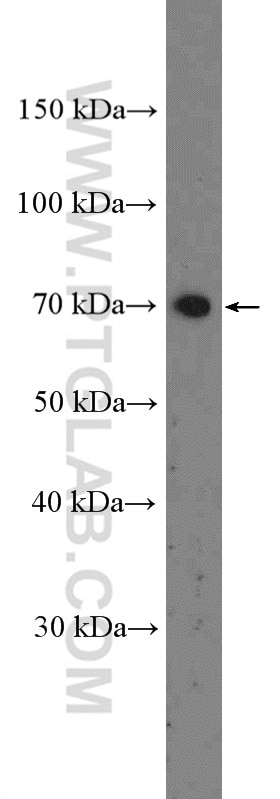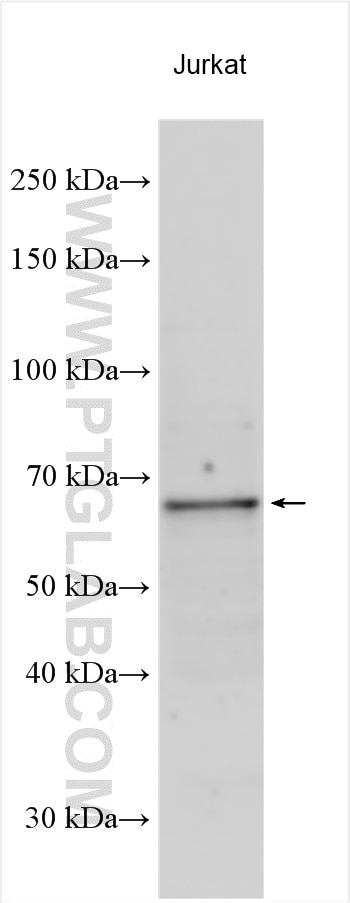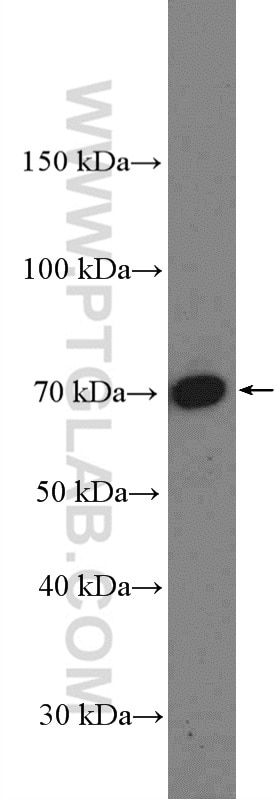Anticorps Polyclonal de lapin anti-MLLT3/AF9
MLLT3/AF9 Polyclonal Antibody for WB, ELISA
Hôte / Isotype
Lapin / IgG
Réactivité testée
Humain, rat, souris
Applications
WB, ELISA
Conjugaison
Non conjugué
N° de cat : 12825-1-AP
Synonymes
Galerie de données de validation
Applications testées
| Résultats positifs en WB | cellules Jurkat, cellules HL-60 |
Dilution recommandée
| Application | Dilution |
|---|---|
| Western Blot (WB) | WB : 1:500-1:1000 |
| It is recommended that this reagent should be titrated in each testing system to obtain optimal results. | |
| Sample-dependent, check data in validation data gallery | |
Informations sur le produit
12825-1-AP cible MLLT3/AF9 dans les applications de WB, ELISA et montre une réactivité avec des échantillons Humain, rat, souris
| Réactivité | Humain, rat, souris |
| Hôte / Isotype | Lapin / IgG |
| Clonalité | Polyclonal |
| Type | Anticorps |
| Immunogène | MLLT3/AF9 Protéine recombinante Ag3528 |
| Nom complet | myeloid/lymphoid or mixed-lineage leukemia (trithorax homolog, Drosophila); translocated to, 3 |
| Masse moléculaire calculée | 568 aa, 63 kDa |
| Poids moléculaire observé | 63-70 kDa |
| Numéro d’acquisition GenBank | BC036089 |
| Symbole du gène | AF9/MLLT3 |
| Identification du gène (NCBI) | 4300 |
| Conjugaison | Non conjugué |
| Forme | Liquide |
| Méthode de purification | Purification par affinité contre l'antigène |
| Tampon de stockage | PBS with 0.02% sodium azide and 50% glycerol |
| Conditions de stockage | Stocker à -20°C. Stable pendant un an après l'expédition. L'aliquotage n'est pas nécessaire pour le stockage à -20oC Les 20ul contiennent 0,1% de BSA. |
Informations générales
MLLT3, also named as AF9, YEATS3, is a 568 amino acid protein, which is a component of the superelongation complex6 and co-operates with DOT1L, which di/trimethylates H3K79 to promote transcription. MLLT3 localizes to active transcription start sites (TSSs) through the YEATS domain, which recognizes active histone marks such as H3K9 acetylation and crotonylation. A truncated MLLT3 that lacks the YEATS domain forms a leukaemic fusion protein with the N terminus of MLL1, which misdirects MLLT3-interacting complexes to induce aberrant gene transcription. MLLT3 also regulates erythroid or megakaryocytic progenitors and was identified as a definitive HSC hub gene during mouse development. Researcher found that the expression of a gene called MLLT3 was closely correlated with blood stem cells'potential to self-renew and that the protein generated by the MLLT3 gene provides blood stem cells with the instructions necessary to maintain its ability to self-renew. It does this by working with other regulatory proteins to keep important parts of the blood stem cell's machinery operational as the cells divide.
Protocole
| Product Specific Protocols | |
|---|---|
| WB protocol for MLLT3/AF9 antibody 12825-1-AP | Download protocol |
| Standard Protocols | |
|---|---|
| Click here to view our Standard Protocols |




